The Three Buddhist Umbrella Organizations in the Buryat Regions
The situation of Tibetan Buddhism in the Buryat regions has changed greatly in the last 30 years. Now in 2023, of the 334 local and 14 umbrella Buddhist societies throughout the Russian Federation, there are about 90 registered local Buddhist societies in ethnic Buryatia, and almost half of them have already built their own temples (datsans).
Most of these societies belong to the three Buryat umbrella organizations, the largest being the Buddhist Traditional Sangha of Russia (BTSR). Most of the BTSR societies lie in ethnic Buryatia, which includes not only Buryatia proper but also the Irkutsk region and the Transbaikal region up to Aginsk. These two parts of the Buryat-Mongol Autonomous Soviet Socialist Republic were cut off from Buryatia by Stalin in 1937. The BTSR also includes several Buddhist societies and datsans outside of the Buryat regions in Bashkiriya, Hakasiya, Kemerovo, Novosibirsk, Habarovsk, Krasnoyarsk, Moscow, and St. Petersburg, as well as in Kalmykia. The Altai Buddhist Society is also a collective member of BTSR.
The other two Buryat umbrella organizations are comparatively small. The Buryat Buddhist Union, headed by the Bandido Khambo Lama Emeritus Khensur Alexander Budayev, unites only 13 Buddhist groups, mainly in Ulan Ude. The third organization, Maidar, includes just three datsans of the Tunka area in Buryatia.
In addition, there are 30 independent Buddhist societies in ethnic Buryatia: 27 in Buryatia proper, two in Transbaikalia, and one in Irkutsk. These include such datsans as Atsagat Datsan, Tsolginsky Datsan, the Ulan Ude Datsan Shakyamuni Zandan Zhuu, and the biggest of all and spiritually most influential Rinpoche Bagsha Datsan, headed by the Tibetan Lama Ven. Yelo (Tibetan abbreviation of Yeshe Lodro) Rinpoche.
The Buddhist Traditional Sangha of Russia (BTSR)
The Buddhist Traditional Sangha of Russia is the successor of the Central Buddhist Board, the only Buddhist organization of the Soviet period. It was renamed as the BTSR in 1997 and obtained a new constitution in 1998 at the Buddhist Congress with the participation of 127 delegates. Now, in 2023, the BTSR embraces 52 Buddhist societies of ethnic Buryatia and 14 Buddhist societies in other areas of Russia.
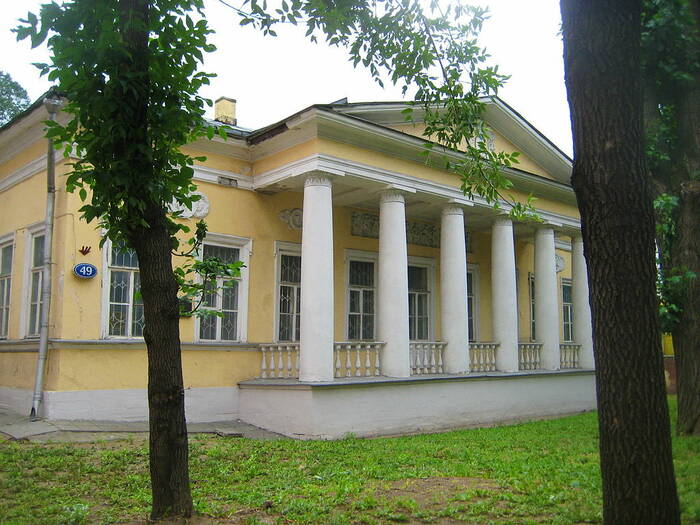
Since 1995, the BTSR has been headed by the genyen (layman) Damba Badmayevich Ayusheev. He received the traditional title of Bandido Khambo Lama, which was soon modernized into more accurate Sanskrit phonetics as Pandito Khambo Lama to avoid the unpleasant association with the international word “bandit.” Being a strong character and effective authoritarian manager, Ayusheev soon gained full administrative and financial control over the majority of datsans and established a strong informal discipline for their abbots. As a Khambo Lama, Ayusheev could nominate or fire any abbots.
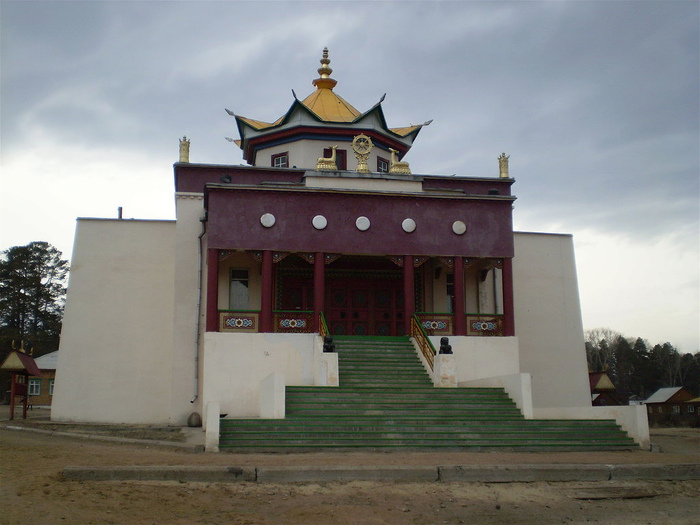
Some people have been unhappy about Ayusheev’s authoritarian tendencies and the controversial aspects of his position. For example, it was reported that the portraits of the Dalai Lama were removed from the main temple when a Chinese delegation arrived, with the later excuse that the portraits were taken out for cleaning. Some think that he did not pay proper respect to the visiting Ninth Bogdo Gegen of Mongolia. When he strongly protested against exhibiting a series of famous Tibetan medical thangkas in the USA, the police had to use force against the BTSR lama protesters, and so on.
Some of Ayusheev’s ideas look strange to the more educated Buddhists. For instance, he is quoted as having said, “Buryats received Buddhism from Damba Dorja Zayayev, while Zayayev received it in his first birth from the Buddha Kashyapa and in the second from Buddha Shakyamuni. You should remember it!” Or “Buryats are saved from samsara by breeding the Buryat species of sheep.” However, the majority of the Buryat people value greater the more prominent sides of his activities, such as the spread of datsans in Buryatia and beyond, the establishment of discipline and order in the monasteries, the respect and influence of the Khambo Lama in Moscow, and his personal relations with the Kremlin, and so on.
These points give some idea of why there appeared two alternative umbrella organizations in Buryatia and 30 independent Buddhist societies, but the Government of the Russian Federation fully supports Ayusheev. The press widely refers to him with the title “The Head of the Buddhists of Russia,” although in fact the National Buddhist organizations of Kalmykia and Tuva and other Buddhist umbrella organizations and individual centers are totally independent from the BTSR. He strongly supports all the policies of the Kremlin. In turn, the Government supports the BTSR financially. In the period of 1994–1998, the BTSR received 1.64 billion rubles (before the denomination of the ruble was reduced 1000/1), in the period of 1998–2003, 27 million rubles, and in the period of 2013–2014, 247 million rubles.
Khambo Lama Ayusheev is the only Buddhist member of the Interreligious Council of Russia and thus is considered to represent all the Buddhists of the country. In March 2023 Ayusheev, who actively supports the Russian “special military operation” in Ukraine, was awarded with a prestigious State Order of Honor for “active social activity, devoted to strengthening friendship between peoples…” It is noteworthy that a disproportionately large number of young Buryat men have been sent to fight in Ukraine.
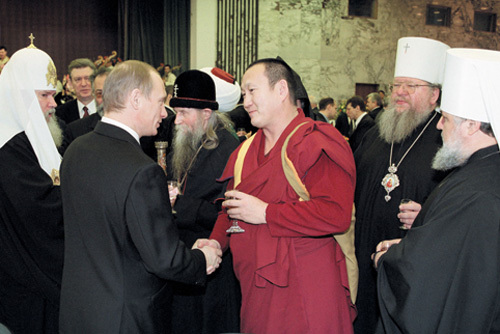
Religious Activities in the Buddhist Traditional Sangha of Russia
The primary service of the lamas in Buryatia is supporting traditional Buddhist culture, celebrating religious festivals, and performing astrological calculations and different rituals at the request of believers. The BTSR is also very active in supporting various Buryat national traditions, reviving the Buryat language, and so on.
The current BTSR religious activity is connected with the “sacred body of Khambo Lama Itigilov” (Dashi Dorzho Itigilov 1852–1927). When he was preparing to die, Itigilov asked for his body to be exhumed after some years. When his body was exhumed in 2002, it was found to be very well preserved, without signs of decay. A special palace was built at Ivolginsky Datsan for Itigilov’s body and thousands of people from various places – President Putin among them – came to Buryatia just to have a look at this body.
Some devotees even claim that Itigilov is still alive. The keeper of the body records Itigilov’s telepathic messages on a daily basis, and these are published on the official site of the BTSR and elsewhere. For example, if you open this site today, Vesak day 04/06/2023, the main page begins with “The Dharma of Dashi Dorzho Itigelov. To a person with a nature of wide consciousness, Khambo Lama [Itigilov] pointed out: ‘Go your own way, not paying attention to others’ opinion.’” He also said, “By worshipping the Buddha, offer your body as a mandala in order that Buddhahood would become present.” On the 11th of April, Itigilov sent the message, “A man should be ready for service,” and so on. The daily messages were published by Pandito Khambo Lama Ayusheev on his Facebook page, and collections of these messages are printed in book form. In this way, a cult has grown around this body, sometimes overshadowing the essential Buddhist practices.
On 23 April 2020, the Buddhist Conference recognized the body of Dashi Dorzho Itigilov as one of the sacred Buddhist objects of Russia. The other two are the unique collection of Tibetan Medical Thangkas copied from the Lhasa originals probably at the end of nineteenth century and the famous statue Zandan Zhuu (Sandalwood Buddha) believed to have been carved during Buddha’s lifetime.
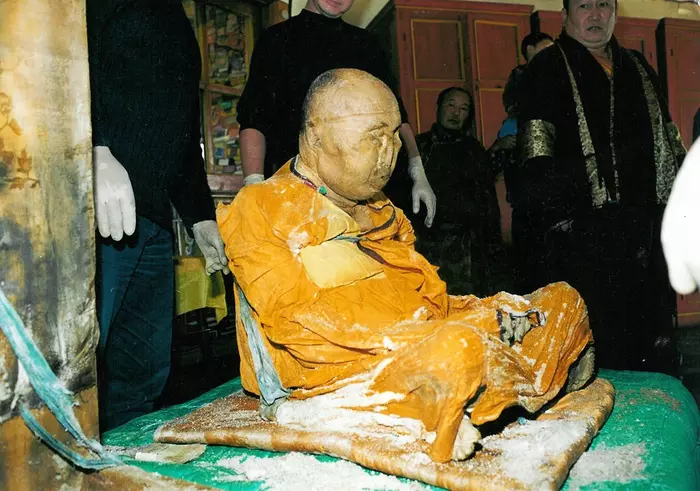
Education in the Buddhist Traditional Sangha of Russia
The Buddhist University Dashi Choinkhorling, called after Damba Darzha Zayayev, was founded at Ivolginsky Datsan in 1991. First it was a college with a two-year basic Buddhist program and 96 students. Now it is a state-licensed university with a five-year program, where besides the traditional Buddhist subjects and the history of Buddhism, the students are taught the basics of modern science, European philosophy, culture, psychology, and sociology. Tuition, housing and food are free for all students. Presently the university has more than 200 students.
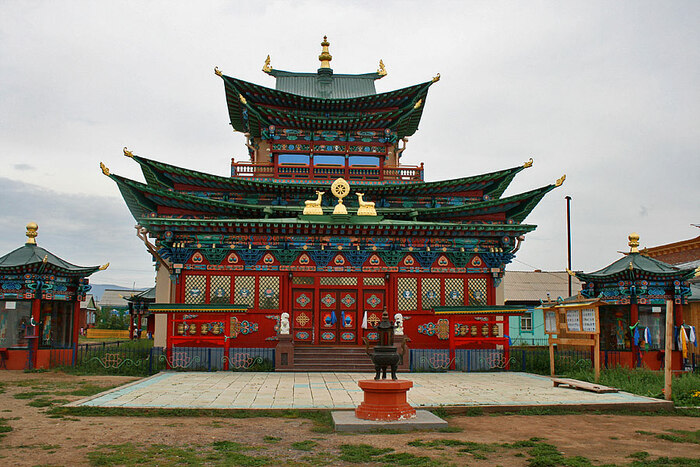
The graduate students at the university receive the diplomas of a “Lama theologian.” Those who continue their studies further can earn the degree of a “gabzha” and even a “geshe.” Some graduates continue their studies at the Drepung Gomang Datsan in India. Only there is it possible for them to receive the highest degree of Geshe Lharampa. The first and only Buryat Geshe Lharampa up until the present is Dobdon Maksarov (Gelong Lobsang Tenpa) from Tsugolsky Datsan. He received his degree in 2019. In 2020, he also received the Geshe Ngagrampa degree in tantra studies at the Gyume Tantric College in India.
There is also a second state-licensed Buddhist institution within the BTSR, the Aginsk Buddhist Academy, located on the grounds of Aginsky Datsan. This academy was started in 1993 as the School of Tibetan Medicine but was soon expanded to also include the faculties of Buddhist philosophy and thangka painting. Unlike the all-male Dashi Choinkhorling at Ivolginsky Datsan, the Aginsk Buddhist Academy is co-educational. 1994, it became affiliated with the Mentsikhang, the Tibetan Medical and Astrological Institute in Dharamsala, India. Still, it is a much smaller institution compared to the Dashi Choinkhorling University. Nowadays it has only two dozen students in the Tibetan Medicine faculty and no one at Philosophy Faculty.
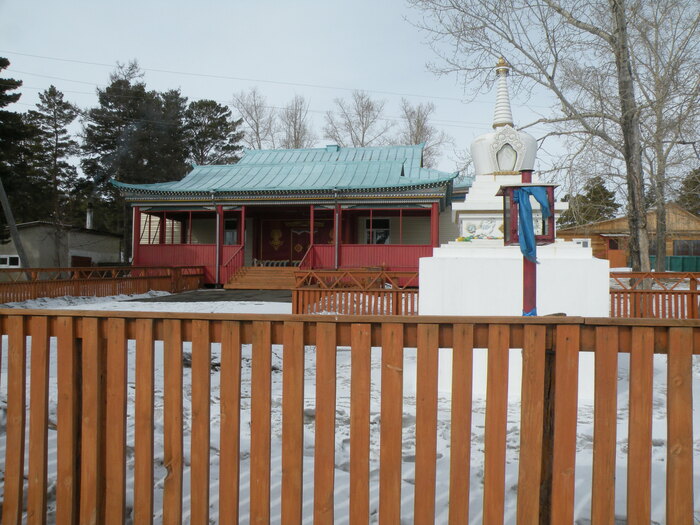
Social and Economic Activities
The production of felt is carried out these days at Ivolginsky Datsan. It is helpful for the sheep breeders as a way to utilize their extra stored wool. The BTSR at the dastan is also active in organizing national festivals and sport competitions such as national wrestling, archery, and so on.
The other two Buryat umbrella organizations – the Buryat Buddhist Union and Maidar – have very little influence and are hardly noticeable in comparison with the BTSR. The same can be said about the Moscow-registered umbrella organization The Central Buddhist Board, which includes several local Buryat Buddhist societies, including the umbrella Buryat Buddhist Union. Presently it is headed by the veteran of the Soviet Government Council for Religious Affairs Dulma Shagdarova from Moscow.
However, a really influential spiritual alternative to the BTSR in Buryatia is the very popular Rinpoche Bagsha Datsan, headed by the experienced Tibetan lama Yelo Rinpoche. Here, they don’t produce felt but are centered on Dharma. Yelo Rinpoche gives teachings and initiations and performs rituals for the local people. There are even good facilities for longer retreats, available also for Buddhists from outside Buryatia. In the last decade, Yelo Rinpoche with the former Kalmyk Shajin Lama Telo Tulku Rinpoche managed to organize in New Delhi, India, and Riga, Latvia, regular yearly teachings by His Holiness the Dalai Lama for Russian citizens, as it was impossible for the Dalai Lama to come to the Russian Federation due to visa complications. Thousands of Russian Buddhists were extremely thankful to the organizers, while the BTSR never took part in organizing these meetings with the Dalai Lama.
There are also Buddhist groups and associations that diverge from the old national Buryat traditions. For example, there are still some remains of the Dandaron group, repressed in the 1970s, as well as some dzogchen followers, and some centers of The Russian Association of the Diamond Way Buddhists of the Karma Kagyu Tradition.
It is also interesting to mention that the Buddhist “feminist” movement is quite noticeable in Ulan Ude. There is the female Buddhist society Green Tara and Datsan Zungan Darjaling for women, where the rituals are performed by the female genyenmas.
In addition, there are some cultural NGOs closely connected with Buddhism, such as The Friends of Tibet Society, The Agwan Dorjiev Foundation (closed in 2008), and the Dharmaraj Foundation, started in 2014 and devoted to the memory of Bidiya Dandaron.